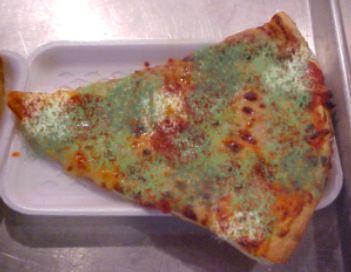Fuzzy pizza
Fuzziness is usually the last thing you would want to associate with a pizza, as it conjures up images of quietly decaying remnants of last week's dinner. However, researchers from University College, Dublin are relying on fuzziness to help deliver you the perfect pizza.

Mmmmm... fuzzy pizza...
As pizza has become more popular, producers have had to develop their manufacturing methods to ensure efficiency and quality - the last thing hungry customers want is a wonky non-circular base and sloppily spread sauce. To this end, Da-Wen Sun and Tadhg Brosnan have used a combination of computer vision and fuzzy logic to monitor the quality of pizza bases and how sauce is spread in pizza
production.
By analysing images of pizza bases, they used computer methods to calculate measures of the quality of the base, such as overall diameter and circularity. Similarly, images of bases spread with sauce provided the information needed to calculate the sauce area percentage and other relevant sauce quality measures.
From this data they then established fuzzy logic rules for the computer to decide whether a photographed pizza was of an acceptable standard. "Fuzzy logic embodies the nature of [the human] mind in some sense," the researchers said in their paper in Journal of Food Engineering. This is because fuzzy logic can use approximate information and uncertainty to generate decisions, just as we can.
Fuzzy logic is based on a mathematical process of deciding to which fuzzy set (e.g. the set of acceptable pizzas, the set of unacceptable pizzas) a fuzzy variable (in this case, the percentage of the pizza base covered in sauce) belongs. The flexibility of fuzzy logic comes from the blurred, or fuzzy, boundaries of these sets - an object can partially belong to a set and the sets can overlap. The sets are described by a mathematical equation called a Membership Function (MF), which gives every object a membership value between 1 (completely in the set) and 0 (completely out of the set). This makes fuzzy logic much more similar to a human assessment of such questions than strict Boolean logic. In Boolean logic an object is either in (an MF of 1) or out (an MF of 0) of a set, whereas in the fuzzy universe, not only can objects be completely in the set, or completely out, but they can "sort of be", or "be just a bit" in the set (an MF somewhere between 0 or 1).
In fact, according to their trials, the researchers' methods of fuzzy logic gave a 92% accurate assessment of sauce spread on pizza bases, compared to human monitoring. An encouraging result for discerning pizza connoisseurs, who may now be asking for an extra topping of fuzzy logic with their next pizza.
Comments
Anonymous
if it aint moving eat it